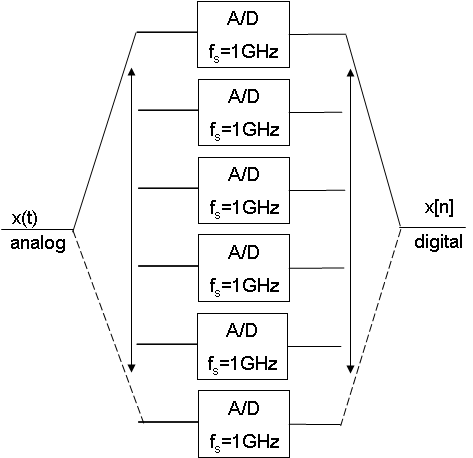Radio Telescope on the far side of the moon
Location and operation of the radio telescope
The radio telescope is to be installed on the far side of the moon
since at this place it will be shielded from most of the man-made noise
which is essential when "listening to signals from deep space".
Since the radio telescope should operate in a way similar to the
telescope in Arecibo, Puerto Rico, it will use the same 300m diameter
dish in order to make measurements of the spectrum between 1 and 4 GHz.
The transmission of the measurement data back to earth will be
digital since we want to make use of the advantages of digital
transmission such as error correction etc.
For the transmission of the data it will make use of a communication
system (with a 6m dish antenna) that is discussed in more detail here.
For power supply we will use solar cells and batteries as back-up for times when the solar cells are shielded from sun light.
Sampling and quantization of spectrum
Hence we need to sample and quantize the spectrum to get a digital signal. In total we have a bandwidth of 3 GHz which means we would require a sampling frequency of at least 6GHz.
Since there is no A/D converter available that provides a sufficient
sampling rate we will have to use multiple A/D converters with a lower
sampling rate and combine the data. A challenge in this approach is
that the A/D converters need to be precisely synchronized in order to
not introduce any errors into the measured signal.
Another parameter is the number of quantization bits we want to use. A
general rule of thumb says that we get a SNR of 6*N dB where N is the
number of quantization bits.
Typical numbers of quantization bits range from 4-16bit. In order to
get a high SNR we would like to choose a high number of quantization
bits (to get a small quantization error), however increasing the number
of quantization bits also increases the required data rate and hence
also the required bandwidth and/or receive SNR in order to reliably
receive the transmitted signal.
Furthermore high-speed A/D converters tend to have a lower number of
quantization bits, so there is another tradeooff: If we want to have a
high number of quantization bits we need to use lower speed A/D
converters and hence to sample the complete spectral bandwidth of 3 GHz
we need to use many low-speed A/D converters which could make the
synchronization more difficult.
Solution 1
As a compromise we could use for example 6x 1GHz A/D converters with
8bit which would give a quantization SNR of 48dB and would result in a
total data rate of Rb = 48
Gbps. We will use this result later on in the design of the relay
system.
To check if 8bit quantization provides sufficient SNR, we need to
calculate
- the noise power of the telescope
- the maximum signal power
Calculation of noise power:
Using Tsys = 20K, bandwidth B=3GHz and k = 1.3807*10-23 J/K, we can calculate PN = k*Tsys*B = 8.2842*10-13W.
Calculation of maximum signal power:
A typical value of power density E for the brightest source in radio
astronomy is 10,000 Janskys = 10-22 W / (Hz*m2).
(from [3])
To calculate the maximum signal power we can use the following formula:
PS = E * B * Pi * (d/2)2 * η = 1.9085*10-8W.
The maximum required SNR is then 10*log10(PS / PN)
= 43.62dB.
Hence we can conclude that quantization with 8bit (SNR = 48dB) yields
sufficient SNR.
However since a 8bit A/D converter never provides an SNR equivalent to
8bits but rather 7.0-7.5bit, we will reduce the data to a 7bit
representation to reduce the required data rate and save bandwidth.
This means that we will get a quantization SNR of 42dB and transmit a
signal with a data rate of 42Gbps.
The figure below shows the operating principle of the system consisting of 6 1GHz A/D converters operating in a time-interleaved fashion and as such being equivalent to a single 6GHz A/D converter:

Solution 2
An easy solution would be to use two 3GHz 8bit A/D converters ADC083000 from the company National Semiconductor[8]. They are designed to be able to operate as an equivalent to a single 6GHz converter without any additional circuitry. This option is probably easier to implement since we do not need to worry about synchronization because that has already been taken care of. However this part is not yet available, the documentation on the webpage says "preliminary".